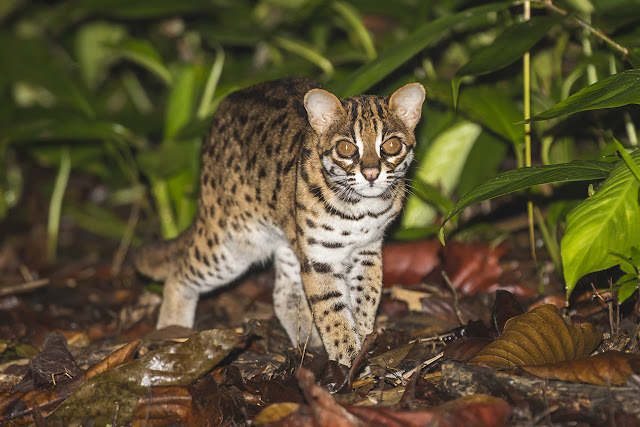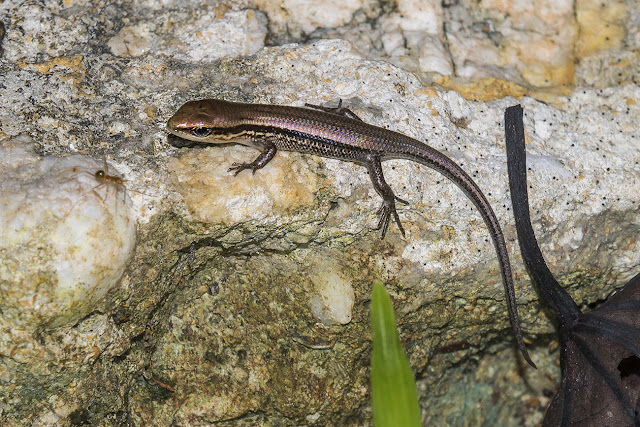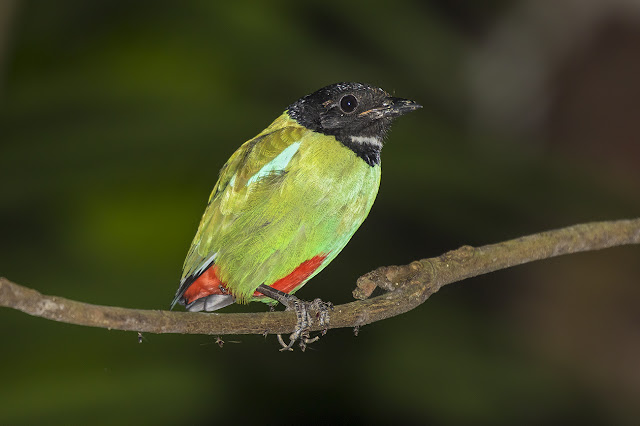Day 3:
We met up with Jason and Robert at 6:30am yet again, they led us again to the back of the resort to look for birds. Not that many birds were seen early on, the calls of Great Argus echoed in the background. One of the resort's star bird is the Hooded Pitta, and Robert found us a calling individual. With a little effort we managed fairly good views of one calling from it's perch. The race muelleri in Borneo have all black head.
Hooded Pitta - race muelleri
A large raptor flew in and perched in a tall tree, we managed to see the bird through layers of branches and leaves and came to the conclusion that it was a pale morph Changeable Hawk Eagle. Nearby, numerous Bornean Brown Barbets made an appearance, a species that was split in recent years, making it a Bornean endemic.
Changeable Hawk Eagle
Bornean Brown Barbet
The best bird of the morning came in form of a Green Broadbill, Robert heard it first and managed to call it in, where it gave superb views! This species is not at all common around Sepilok, and I've only ever seen this species very briefly at Gomantong Cave many years ago, so I was very happy to finally get to see one up close!
Green Broadbill - a complete surprise!
Back at the resort, Jason's staff told him that they had found a Bornean Keeled Pit Viper. It was found just outside one of the hotel rooms! I managed to move it to a safer location where we took some more photos in a more natural setting.
Bornean Keeled Pit Viper
Breakfast provided some easy birding opportunities, including a few Blue-crowned Hanging Parrots which perched on top of the trees. Crimson Sunbirds and Orange-bellied Flowerpeckers were both regularly seen around the restaurant.
Blue-crowned Hanging Parrot
Crimson Sunbird - male
Orange-bellied Flowerpecker - male
After breakfast we headed back towards RDC. Unfortunately, Hoiling was not in top form and decided to stay in the resort and rest. Near the car park Robert showed us a nesting Malaysian Pied Fantail, their perfect looking nests always amazes me, we observed the bird cementing nesting materials with spider webs.
Malaysian Pied Fantail
Along the trails, Black-capped Babblers were often seen foraging on the ground, walking along in a pipit like fashion. While the Chestnut-winged Babblers are more often found foraging in trees and bushes, their blue neck pouch often show through when they call.
Black-capped Babbler
Chestnut-winged Babbler
A wide array of insects and butterflies were seen along the trail, including an incredible looking Pygoplatys lancifer, a species of stink bug. While the large and graceful Idea stolli and very colourful Paralaxita telesia ines certainly kept Kenneth; our butterfly enthusiast very happy.
Pygoplatys lancifer
Tanaecia sp.
Thaumantis klugius lucipor
Idea stolli
Paralaxita telesia ines
Many Red-eyed Bulbuls were seen at the fruiting tree along the Kingfisher Trail, the Jambu Fruit Dove was seen again, but this time it was slightly more obscured. The Rufous-collared Kingfisher showed exceptionally well again, this time in much better lighting.
Red-eyed Bulbul
Rufous-collared Kingfisher - male
Things quietened down slightly after 10:30am, just as we decided to head back earlier, Robert picked up a distant call of a Bornean Banded Kingfisher! One of my top target species for this trip! We played it's call to see if it responds, and sure enough a female flew in and perched above our heads! It gave wonderful views for everyone.
Bornean Banded Kingfisher - female
Soon after Jason heard the male calling from nearby, with a little effort we found it perched much higher up. Luckily, it later came lower down to the female and we enjoyed phenomenal views of this cracking bird up close. This is a species I've repeatedly looked for during my previous visits but never quite connected, so I was extremely pleased with this encounter.
Bornean Banded Kingfisher - male
It started raining soon after we returned to the resort, but there were plenty of other interesting things to see around the resort, including a very confiding Green Crested Lizard, while Borneo Skinks are often seen around the resort's boardwalk.
Green Crested Lizard
Borneo Skink
While we waited for the rain to stop, Jason showed us a few turtles from the resort's pond, including a newly hatched Malaysian Box Turtle and a very handsome Asian Leaf Turtle.
Malaysian Box Turtle
Asian Leaf Turtle
The restaurant provided a perfect place to wait for birds in the rain, few birds came through including a male Grey-and-Buff Woodpecker and a few Little Green Pigeon, the latter is a lifer for me, males are quite brilliantly coloured. Later we were surprised by yet another female Jambu Fruit Dove! I guess when you see one it usually means there are a few around.
Grey-and-Buff Woodpecker - male
Little Green Pigeon - male
Jambu Fruit Dove - female
A male Yellow-rumped Flowerpecker with a deformed bill often visited the mistletoes next to the restaurant, it gave us a great look at this Bornean endemic. The resident Stork-billed Kingfisher also provided us with some fun in the drizzly weather.
Yellow-rumped Flowerpecker - male
Stork-billed Kingfisher
Once the rain cleared we headed out again to the back of the resort, a few Dollarbirds perched ontop of the trees. While another Hooded Pitta showed up, a few who missed the early morning birding was able to catchup.
Dollarbird
Hooded Pitta
A few very confiding Black-and-Yellow Broadbills provided wonderful views, they came down to eye-levels which everyone enjoyed immensely. Nearby a pair of Buff-necked Woodpeckers made an appearance, they were feeding on the termites on an old stump.
Black-and-Yellow Broadbill - female
Buff-necked Woodpecker - female
Buff-necked Woodpecker - male
A male Asian Fairy Bluebird showed briefly, while a White-bellied Woodpecker gave distant views, this species is fairly common at Sepilok and quite often heard drumming.
Asian Fairy Bluebird - male
White-bellied Woodpecker - female
The White-crowned Shama required a little effort, but it showed itself in the end, this Bornean endemic is replaced by the White-rumped Shama further south. As we were walking along the trail, we suddenly encountered a large bird that flew out from the tree above, it was clearly a Hornbill. Jason, Kenneth and I all saw the bird and all of us noticed the long tail, this could only mean Helmeted Hornbill! Unfortunately by the time I wanted to take a photo it was already gone. Helmeted Hornbill had been recorded at Sepilok in the past, but extremely rarely, so it was truly a surprise for me!
White-crowned Shama
We waited around for the Helmeted Hornbill but it never returned. Quite a few Blue-throated Bee-eaters perched on the bamboo nearby kept us entertained. As it got darker, our chances for the Helmeted Hornbill diminished, so we decided to head back to the resort.
Blue-throated Bee-eater
After dinner we headed to the back of the resort once again to look for other wildlife. We added a Paddy Frog as well as a Copper-cheeked Frog. The Rough-sided Frog also seemed quite common in the area, we saw a few throughout the evening. The most interesting frog for me was probably the Puddle Frog.
Paddy Frog
Copper-cheeked Frog
Rough-sided Frog
Puddle Frog
The best find of the evening came in form of a Sunda Leopard Cat, Robert first spotted it at a distance, surprisingly instead of running off, this Sunda Leopard Cat came closer and closer until it was merely 2m from us! It was such a treat to be so close to this amazing creature.
Sunda Leopard Cat
Finally, Jason and Robert found us this awesome Black Emperor Scorpion, it was quite large and very impressive looking. All scorpions reflect bright blue under UV light, and it certainly makes finding them much easier in the wild. Having had a fairly successful evening, we called it a night.
Asian Forest Scorpion
Day 4:
Our morning once again started behind the resort, we started extra early hoping to see the Bornean Gibbons, but we only heard them from a distant. Birds were fairly quiet except for a pair of Red-naped Trogons which showed fairly well. A male Diard's Trogon also showed briefly but was very shy.
Red-naped Trogon - male
Red-naped Trogon - female
Things were quiet overall, a few Raffle's Malkoha made an appearance, while a male Yellow-rumped Flowerpecker gave great views at close range. Since things did not improve much we headed back for breakfast.
Raffle's Malkoha - male
Yellow-rumped Flowerpecker - male
Back at the resort, Robert spotted a recently fledged Black-and-Red Broadbill. A Crimson Sunbird came to visit the flowers at breakfast.
Black-and-Red Broadbill - fledgling
Crimson Sunbird - male
Since it was the first visit to Borneo for everyone except me, we thought it was a good idea for them to see the iconic Proboscis Monkeys. Robert suggested we pay a visit to Labuk Bay, a sanctuary for Proboscis Monkey just 30 minutes drive from Sepilok. On our way to Labuk Bay we spotted two raptors by the road which turned out to be Black-winged Kites. One of which caught what looks like a rat.
Black-winged Kite
Labuk Bay Proboscis Monkey Sanctuary is a small patch of coastal mangroves, surrounded by oil palm plantations. The monkeys can be found along the mangroves, there are two feeding platforms which tourists often visit to see these monkeys up close during scheduled feeding time. We arrived slightly earlier than the 11am feeding time, so we spent sometime in the nearby mangroves to look for birds, there weren't that many birds around except for a few Collared Kingfishers. We heard a Common Flameback but it never materialised.
Collared Kingfisher
We were amazed by the Blue Fiddlers Crab, a very colourful species that is bright blue in colour! There were also many mudskippers around the mangroves, I believe they are Boddart's Blue-spotted Mudskippers. While Asian Water Monitors are fairly common around here.
Blue Fiddlers Crab
Boddart's Blue-spotted Mudskipper
Asian Water Monitor
We found a group of Proboscis Monkeys feeding along the road, they provided wonderful views in a much more natural setting than the feeding stations. Adult males with their almost comical nose almost certainly will make anyone smile.
Proboscis Monkey - male
Proboscis Monkey - young male
We arrived at the feeding platform before the actual feeding time, there were plenty of Proboscis Monkeys already present. There were at least 50 - 60 monkeys, a few were adult males, one of the biggest male which I presume was an alpha male over looked the group, occasionally chasing after other younger males to 'discipline' them. There were also plenty of mothers with very young babies.
Proboscis Monkey - male
Proboscis Monkey - mother with young
The feeding station does not look entirely natural, although it does provide with great opportunity to get super close to these monkeys, you also get to see all sorts of different behaviours within the group, including play fighting and on occasion...some X-rated action.
Proboscis Monkey - signature big nose
Proboscis Monkey - the alpha male at work...
The platform also attracted many Silver Langurs, they are much smaller in comparison with the Proboscis Monkeys, most of them were resting in the shades of the viewing deck, hoping to get away from the heat. They were also fed by the staff, mostly with long beans.
Silver Langur
Not many birds were around the feeding platform, I heard a few Bold-striped Tit-Babbler and managed to call them in. This species was split with the fairly similar Pin-striped Tit-Babbler, it is found throughout Borneo as well as Java. A Rufous-tailed Tailorbird was also found nearby.
Bold-striped Tit-Babbler
Rufous-tailed Tailorbird
We headed back on our van for lunch, just before that we stopped briefly by a Baya Weaver colony. While this species is common throughout South East Asia, this species was previously not recorded in Borneo, a feral population had established themselves around Sandakan, and now they seem to be pretty common.
Baya Weaver
After lunch and a little rest we headed to the Sepilok Orangutan Rehabilitation Centre (SORC). This is a major tourist attraction in the area, although birders had also yielded some good species in the past. The boardwalk here cuts through some half decent habitat, here you may get to see semi wild Orangutans roaming the forest. Kenneth spotted a beautiful Dark Posy, we also saw a damselfly which I believe is Vestalis amaryllis.
Boardwalk of SORC
Bornean Orangutan
Dark Posy
Vestalis amaryllis
The nursery provide tourists with an air conditioned room to see Orangutans through glass windows, I wasn't a big fan of this and preferred the see the Orangutans outside. The feeding station is another option for viewing Orangutans, although during feeding time we saw a lot more Pig-tailed Macaques than Orangutans.
Bornean Orangutan
Pig-tailed Macaque
There were very few birds seen at the SORC, we couldn't find any White-fronted Falconet amongst the dead trees, the only bird of prey we added was a juvenile Rufous-bellied Eagle. We also found a male Black Hornbill in the distant.
Rufous-bellied Eagle - juvenile
Black Hornbill - male
We arrived back at the resort later in the afternoon, while most went back to rest in their rooms, Kenneth, Jason and I walked around the resort looking for different birds. Things were however very quiet, we only managed to find two Blue-eared Kingfishers at the far end of the resort, an adult with blue ears and a juvenile with orange ears.
Blue-eared Kingfisher - adult
Blue-eared Kingfisher - juvenile
Hoiling on the other hand found a very interesting Whip Scorpion in her room, it gave off a foul smell upon being 'captured' with a cup over it, which is the Whip Scorpion main defence mechanism, the offensive liquid is known to contain acetic acid.
Whip Scorpion
After dinner we went out around the resort for yet another night walk. Flat-tailed Geckos are by far the commonest geckos around the resort. The much larger Spotted House Gecko were also fairly commonly seen. We also had a bit of fun with a very large milipede.
Flat-tailed House Gecko
Spotted House Gecko
A very large Milipede
A few moths around the light kept Hoiling busy, the most eye-catching was probably a Ischyja subreducta, it took us a little effort to get it to show off it's blue hind wings.
Ischyja subreducta
At another small pond within the resort (there are so many!) we found a few Common Southeast Asian Tree Frogs, the much larger File-eared Tree Frogs were also present.
Common Southeast Asian Tree Frog
File-eared Tree Frog
Around the forest trail at the back of the resort, we encountered a Kalophrynus meizon, also known as the Borneo Big Sticky Frog, this was probably one of my favourite frog on this trip. We also saw a few Copper-cheeked Frogs.
Borneo Big Sticky Frog - Kalophrynus meizon
Copper-cheeked Frog
Although skinks are usually seen during the day (most slither away before I can even get a photo!), some are encountered at night, for example this young skink which I believe is within the genus Sphenomorphus and a beautiful Brown's Mabuya.
Sphenomorphus sp.
Brown's Mabuya
Of the many Huntsman Spiders we saw, the most impressive was probably this Heteropoda boiei, also known as the Lichen Huntsman Spider. Another Hunstman Spider I did not recognise but had very distinctive white legs.
Heteropoda boiei
Sparassidae sp.
A Brown Boobook kept teasing us nearby, but like all the owls on this trip it never showed despite being extremely close. A Barred Eagle Owl also called, but was not even close to showing. The only bird we managed to see was a Hooded Pitta at it's night roost. Since none of the owls cooperated, we called it a night.
Hooded Pitta - at night roost
















































































































No comments:
Post a Comment